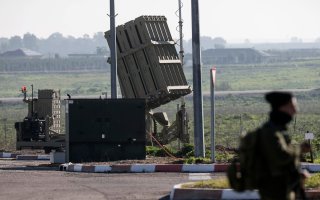Five Weapon of War Israel Has That Russia Would Love to Have
Moscow and Jerusalem have substantially stepped up their military cooperation in recent years, a trend that has made the United States somewhat nervous about the technology it exports to Israel.
Here's What You Need to Remember:
In many ways, Israel and Russia have taken opposite approaches to providing for national security. Israel stands at the technological frontier, while Russia has struggled to keep its national innovation system vital and healthy. Moreover, over the years Russian arms have populated the armies and air forces of Israeli’s enemies.
Nevertheless, Moscow and Jerusalem have substantially stepped up their military cooperation in recent years, a trend that has made the United States somewhat nervous about the technology it exports to Israel. Israeli drones have flown in Russian service in the war in Ukraine, and Israeli electronics have helped improve Russian systems in other ways. Here are five Israeli defense capabilities that Russia would like to have:
Missile Defense
Although the Soviet Union helped pioneer the first anti-ballistic missile systems, Russian technology has fallen behind the West, and especially the Israelis. The United States and Israel (often in collaboration) have committed immense resources to developing a system to defend against a variety of ballistic projectiles. On the US side, the effort has concentrated mostly on medium and long-range ballistic missiles; on the Israeli, it has focused on the entire array of threats, including low-cost, low-technology rockets.
Ballistic projectiles do not pose an overwhelming threat to Russia at the moment, but if Moscow’s efforts to improve its air defense network continues to succeed, such missiles may again come to represent the central plank of NATO’s deterrent. If so, anti-ballistic missiles systems will again become a key component of Russia’s defense strategy.
SPIKE
Russia boasts some excellent anti-tank munitions, including the 9M133 “Kornet” missile, designed to kill main battle tanks such as the Merkava, Abrams, and Challenger II. A laser guided missile, Kornets damaged several Western tanks in the early days of the Iraq War, and in the 2006 Israeli War against Hezbollah.
The Israeli SPIKE family of missiles has capabilities that many variants of the Kornet lack, however. This includes “fire and forget” and top attack profiles, which allow the SPIKE to hit enemy tanks at their most vulnerable. Moreover, the SPIKE has proven remarkably flexible in deployment, serving on board a wide variety of different Israeli delivery platforms.
Intelligence, Surveillance, and Reconnaissance (ISR)
The experience of several wars in Gaza, not to mention the 2006 conflict against Hezbollah and the ongoing Occupation of the West Bank, has given the Israeli national security state an unparalleled ability to integrate information into its frontline operations. This integration has an administrative component (the various organizations that constitute Israeli national defense have become strikingly efficient at sharing and operationalizing information) but also a technological aspect.
Using a variety of electronic and tactical aviation systems, Israel has developed an unparalleled capability to create an image of the battlespace. These system including biometric storage networks, UAVs, and advanced optical systems, among others. Surveillance and intelligence fusion systems of this nature could serve Russia well in Syria, Chechnya, Ukraine, and elsewhere.
Conscription
Russia has many excellent, professional soldiers. Russia does not, however, have a functional system of conscription that can identify and train the most capable potential soldiers from within its population. The Russian system of conscription has become a disaster, with many of the most capable potential recruits finding ways to escape service, and a training experience that has become increasingly brutal.
Israel’s system of conscription, on the other hand, remains one of the healthiest in the world. Despite a few notable problems (objections to service in the Occupation, objection from religious minorities), the Israeli national service program continues to effectively harness the country’s best human capital. Israel obviously cannot export the foundation of this system to Russia, but it could assist with administrative reforms designed to improve Russian performance.
Avionic Systems
Russia’s air force consists of a wide array of generation 4 and 4.5 fighter aircraft, mostly upgraded from Cold War models. The degree of upgrade, however, has proven very uneven. Moreover, the Russian electronics industry has struggled to provide advanced, reliable avionic upgrades. In Syria, for example, Russian system of targeting, detection, and discrimination have trailed their Western counterparts, a gap that has had both military and diplomatic costs.
With an electronics industry tightly connected to the military aerospace sector, Israel has specialized in the kind of upgrades that Russian aircraft could definitely use. These include advanced radars, sensor fusion systems, and sensor pods necessary for the targeting of precision-guided munitions. Tighter collaboration between Israel and Russia could make Russian fighters and bombers far more lethal.
The Final Salvo
As Israel has sought to expand its diplomatic base beyond the United States and Western Europe, it has increasingly developed positive connections with Russia and points east. This effort has included both commerce and diplomacy; Israeli technology has already found its way into various militaries around the world, including Russia.
At the same time, the Russian military industry requires consistent infusions of technology in order to complete the transition from the post-Cold War doldrums. Notwithstanding the longstanding strains between the two countries (Iran, the future of the Assad regime) the Moscow-Jerusalem relationship may prove fruitful for both countries in the next decades.
Robert Farley, a frequent contributor to the National Interest, is author of The Battleship Book. He serves as a senior lecturer at the Patterson School of Diplomacy and International Commerce at the University of Kentucky. His work includes military doctrine, national security and maritime affairs. He blogs at Lawyers, Guns and Money, Information Dissemination, and the Diplomat.
This first appeared in 2016 and is being republished due to reader interest.

